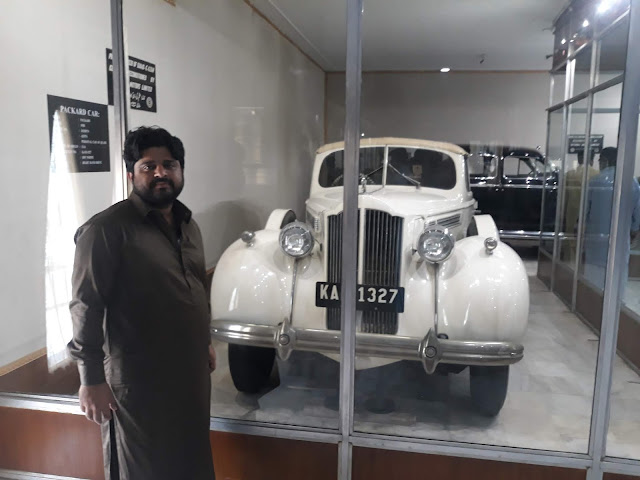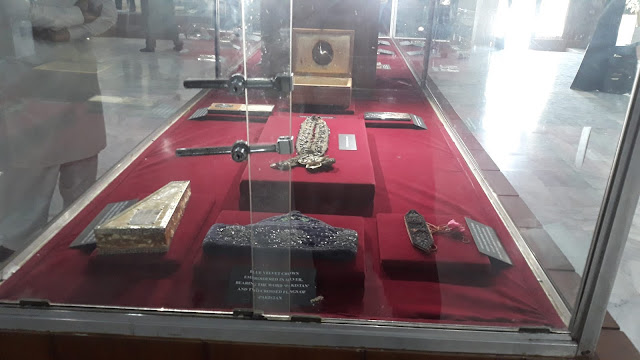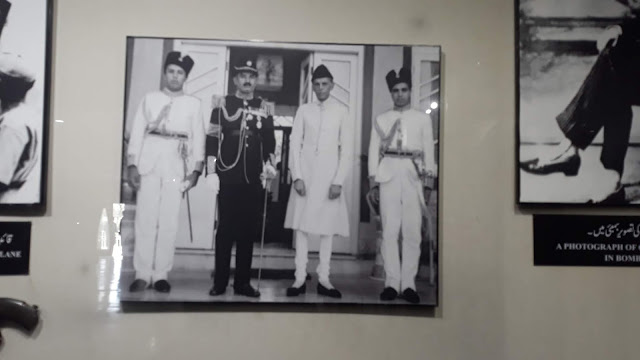Garhi Khuda Bux Bhutto is a village in the Larkana District of Pakistan's Sindh province. It is located about 250 kilometers northwest of Karachi and is known as the ancestral village of the Bhutto family, a political dynasty in Pakistan. The village is home to the Bhutto family's mausoleum, where several members of the family, including former Prime Minister Zulfikar Ali Bhutto and his daughter Benazir Bhutto, are buried.
The mausoleum at Garhi Khuda Bux Bhutto is a popular tourist attraction, and it attracts many visitors each year who come to pay their respects to the Bhutto family and learn about the family's role in Pakistan's history. The mausoleum is also a cultural and political hub, and it is often the site of political rallies and events.
In addition to the Bhutto mausoleum, the village of Garhi Khuda Bux Bhutto is also home to a number of other historical and cultural sites, including the Bhutto Museum and the Tomb of Mir Murtaza Bhutto. Visitors to the village can also explore the surrounding countryside, which is known for its lush greenery and agricultural fields.

Garhi Khud Bux Bhutto is the Place of Bhutto Family. The history of mausoleum at Garhi Khud Bux in Larkana began in 1979 when Zulfikar Ali Bhutto was laid to rest here.Though little know at that time, this was the ancestral graveyard of the Bhutto Family.
Deceased Bhuttos: Buried at Ghari Khuda Baksh
Sir Shah Nawaz Khan Bhutto and his wife, Lady Khurshid
Sikander Bhutto
Imdad Ali
Zulfikar Ali Bhutto
Shahnawaz Bhutto
Murtaza Bhutto
Benazir Bhutto
Nusrat Bhutto
Garhi Khuda Bux Tour with Friends
In Qamber Shahid, Ramiz , Sartaj and Mushtaq decided to visit the Garhi Khud Bux By Roud From qamber to larkana than we reached in Garhi Khud Bux Bhutto and We Visit The Shrines of Bhutto Family. Lot of people from all our Pakistan came here and visit the graveyard of Bhutto Family. All PPP MPA and MNA Visit this Place in Political days of Bhutto Family.For tour this place is Safe and secure basic utilities available here and small market is also available for visitor.
Garhi Khud Bux Bhutto Shaheed Zulfiquar Bhutto National ID Card
In Garhi Khud Bux Shaheed Zulfiqar Ali Bhutto NIC is Available in Big Size for Visitors they can take a good Photos over there. There is a Photo Gallery of Bhutto family and Party workers. Garhi Khuda Bux is one of best place for Visit in Larkana Sindh.
1.Sir Shah Nawaz Khan Bhutto and his wife, Lady Khurshid
Sir Shah Nawaz Khan Bhutto was a Pakistani politician who served as the Chief Minister of Sindh province and as a member of the country's National Assembly. He was a member of the Bhutto family, a political dynasty in Pakistan, and was the father of former Pakistani Prime Minister Zulfikar Ali Bhutto. Sir Shah Nawaz Khan Bhutto was born in 1893 in the village of Bhutto, in the Larkana District of Sindh province.
Sir Shah Nawaz Khan Bhutto was married to Lady Khurshid, who was also known as Khursheed Bhutto. She was a political figure in her own right and was active in the Pakistani independence movement. Lady Khurshid was born in 1913 and was the daughter of a wealthy landowner. She married Sir Shah Nawaz Khan Bhutto in 1930 and had four children with him, including Zulfikar Ali Bhutto.
Both Sir Shah Nawaz Khan Bhutto and Lady Khurshid played important roles in Pakistani politics and are remembered as influential figures in the country's history. Sir Shah Nawaz Khan Bhutto died in 1957, and Lady Khurshid passed away in 2003.
2.Sikander Ali Bhutto
Sikander Bhutto was a Pakistani politician and member of the Bhutto family, a political dynasty in Pakistan. He was the younger brother of former Pakistani Prime Minister Zulfikar Ali Bhutto and the uncle of former Pakistani Prime Minister Benazir Bhutto. Sikander Bhutto was born in 1933 in the village of Bhutto, in the Larkana District of Sindh province.
Sikander Bhutto was involved in Pakistani politics from a young age and served in various government positions throughout his career. He was a member of the Pakistan Peoples Party (PPP), which was founded by his brother Zulfikar Ali Bhutto. Sikander Bhutto also served as a member of the National Assembly of Pakistan and held several ministerial positions, including Minister of Agriculture and Minister of Food.
Sikander Bhutto died in a car accident in 1980, at the age of 47. He is remembered as a prominent political figure in Pakistan and as a member of the influential Bhutto family.
3.Imdad Ali Bhutto
Imdad Ali Bhutto was a Pakistani politician and member of the Bhutto family, a political dynasty in Pakistan. He was the brother of former Pakistani Prime Minister Zulfikar Ali Bhutto and the uncle of former Pakistani Prime Minister Benazir Bhutto. Imdad Ali Bhutto was born in 1930 in the village of Bhutto, in the Larkana District of Sindh province.
Imdad Ali Bhutto was involved in Pakistani politics from a young age and served in various government positions throughout his career. He was a member of the Pakistan Peoples Party (PPP), which was founded by his brother Zulfikar Ali Bhutto. Imdad Ali Bhutto also served as a member of the National Assembly of Pakistan and held several ministerial positions, including Minister of Food and Agriculture.
Imdad Ali Bhutto died in a car accident in 1980, at the age of 50. He is remembered as a prominent political figure in Pakistan and as a member of the influential Bhutto family.
4.Zulfikar Ali Bhutto
Zulfikar Ali Bhutto was a Pakistani politician and statesman who served as the President of Pakistan and later as the Prime Minister of Pakistan. He was the founder of the Pakistan Peoples Party (PPP) and is considered one of the most influential leaders in Pakistani history.
Zulfikar Ali Bhutto was born in the village of Bhutto in the Larkana District of Sindh province in Pakistan in 1928. He received his education in Pakistan and the United Kingdom, studying law and political science. He entered politics at a young age and rose to prominence in the government of President Ayub Khan, serving as Foreign Minister and later as Minister of Energy and Natural Resources.
In 1971, Zulfikar Ali Bhutto became the President of Pakistan after the country's defeat in the Bangladesh War. He later resigned from the presidency and was elected Prime Minister in 1973. As Prime Minister, Bhutto implemented a number of social and economic reforms, including land reform and the nationalization of industries. He was also instrumental in building Pakistan's nuclear program.
Zulfikar Ali Bhutto was overthrown in a military coup in 1977 and was later sentenced to death by a military tribunal. He was executed in 1979, sparking widespread protests and outrage in Pakistan and around the world. Despite his controversial legacy, Bhutto remains a significant figure in Pakistani history and is widely remembered as a champion of democracy and social justice.
5.Shahnawaz Bhutto
Shahnawaz Bhutto was a Pakistani politician and member of the Bhutto family, a political dynasty in Pakistan. He was the youngest son of former Pakistani Prime Minister Zulfikar Ali Bhutto and the brother of former Pakistani Prime Minister Benazir Bhutto. Shahnawaz Bhutto was born in 1958 in Karachi, Pakistan.
Shahnawaz Bhutto was involved in Pakistani politics from a young age and served as an advisor to his sister Benazir Bhutto when she was Prime Minister of Pakistan. He was also a member of the Pakistan Peoples Party (PPP), which was founded by his father Zulfikar Ali Bhutto.
Shahnawaz Bhutto died under mysterious circumstances in 1985 at the age of 27. His death was the subject of much speculation and controversy, and it has never been fully explained. Despite his untimely death, Shahnawaz Bhutto is remembered as a prominent figure in Pakistani politics and as a member of the influential Bhutto family.
6.Murtaza Bhutto
Murtaza Bhutto was a Pakistani politician and member of the Bhutto family, a political dynasty in Pakistan. He was the son of former Pakistani Prime Minister Zulfikar Ali Bhutto and the brother of former Pakistani Prime Minister Benazir Bhutto. Murtaza Bhutto was born in 1954 in Karachi, Pakistan.
Murtaza Bhutto was involved in Pakistani politics from a young age and was a member of the Pakistan Peoples Party (PPP), which was founded by his father Zulfikar Ali Bhutto. He served as a member of the National Assembly of Pakistan and held several ministerial positions, including Minister of Culture and Minister of Tourism.
Murtaza Bhutto was involved in a long-running political feud with his sister Benazir Bhutto and was accused of plotting to overthrow her government. In 1996, Murtaza Bhutto was killed in a shootout with police in Karachi, sparking widespread protests and outrage. His death remains controversial and has never been fully explained. Despite his troubled legacy, Murtaza Bhutto is remembered as a prominent figure in Pakistani politics and as a member of the influential Bhutto family.
7.Benazir Bhutto
Benazir Bhutto was a Pakistani politician and stateswoman who served as the Prime Minister of Pakistan. She was the first woman to hold this position in a Muslim-majority country and is considered one of the most influential leaders in Pakistani history.
Benazir Bhutto was born in 1953 in Karachi, Pakistan, and was the daughter of former Pakistani Prime Minister Zulfikar Ali Bhutto. She received her education in Pakistan and the United Kingdom, studying economics and political science. After her father was overthrown in a military coup and later executed, Benazir Bhutto became involved in Pakistani politics and became the leader of the Pakistan Peoples Party (PPP), which was founded by her father.
In 1988, Benazir Bhutto was elected Prime Minister of Pakistan, becoming the first woman to hold this position in a Muslim-majority country. She served two terms as Prime Minister, from 1988 to 1990 and from 1993 to 1996. During her time in office, she implemented a number of social and economic reforms and worked to improve relations with other countries.
Benazir Bhutto was assassinated in 2007 while campaigning for a third term as Prime Minister. Her death sparked widespread protests and outrage, and her legacy as a champion of democracy and social justice remains strong in Pakistan.
8.Nusrat Bhutto
Nusrat Bhutto was a Pakistani politician and the wife of former Pakistani Prime Minister Zulfikar Ali Bhutto. She was also the mother of former Pakistani Prime Minister Benazir Bhutto and a member of the Bhutto family, a political dynasty in Pakistan.
Nusrat Bhutto was born in 1929 in the village of Bhutto, in the Larkana District of Sindh province. She was involved in Pakistani politics from a young age and was an active member of the Pakistan Peoples Party (PPP), which was founded by her husband Zulfikar Ali Bhutto. She served as a member of the National Assembly of Pakistan and held several ministerial positions, including Minister of Social Welfare and Minister of Women's Affairs.
Nusrat Bhutto was known for her work on behalf of women's rights and social justice, and she was a strong advocate for the rights of marginalized communities in Pakistan. She died in 2011 at the age of 82. Despite her controversial legacy, she is remembered as a prominent figure in Pakistani politics and as a member of the influential Bhutto family.

















































































